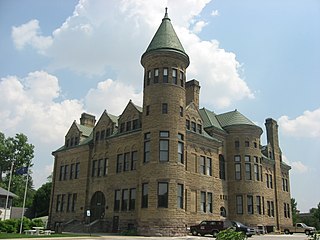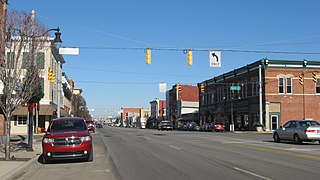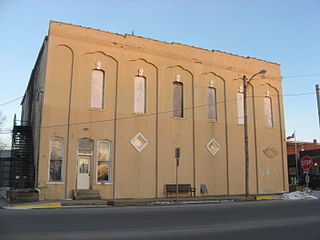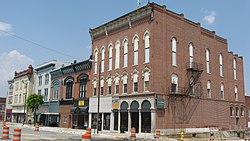
The Clinton County Courthouse is a historic courthouse located at 50 North Jackson Street in Frankfort, Clinton County, Indiana, United States. The Clinton County Courthouse dates from 1882–1884. It was designed by George W. Bunting, who also designed courthouses in Anderson and Franklin. The Clinton County Courthouse is a three-story, Second Empire style limestone building adorned with statuary and a 165-foot domed central tower with a clock. The courthouse cost $170,450 to build in 1882. The courthouse is still in use as the county courthouse.

The Richmond Downtown Historic District is an area of primarily commercial buildings and national historic district located at Richmond, Wayne County, Indiana. The district encompasses 47 contributing buildings located along the National Road. It developed between about 1868 and 1960 and includes representative examples of Italianate, Romanesque Revival, Queen Anne, Classical Revival, and Chicago School style architecture. Located in the district is the separately listed Murray Theater. Other notable buildings include the I.O.O.F. Building (1868), Hittle Building (1878), Tivoli Theater (1926), Romey's Building (1920), George H. Knollenberg Building (1877), Kresge Building, Dickinson Building (1880), former U.S. Post Office (1905), and YMCA (1908).

Geneva Downtown Commercial Historic District is a national historic district located at Geneva, Adams County, Indiana, USA. It encompasses 22 contributing buildings in the central business district of Geneva. were built between about 1882 and 1930, and include notable examples of Italianate and Romanesque Revival style commercial architecture. Notable buildings include the M.E. Hutton Carriage Shop (1895-1896), Briggs Hardware (1882), Shamrock Block, and the Independent Order of Odd Fellows building (1906).

Courthouse Historic District is a national historic district located at Logansport, Cass County, Indiana. The district encompasses 79 contributing buildings and one contributing site in the central business district of Logansport. It has a mix of institutional, governmental, and commercial buildings and notable examples of Late Victorian and Romanesque Revival style architecture. Notable contributing resources include the Masonic Hall (1896), Elks Lodge No. 66 (1907), Douglass Building, McCaffey Building, Logansport-Cass County Public Library (1942), The State Theater, United States Post Office (1925), Bank Building, and Watts Building (1901).

Old Frankfort Stone High School, also known as Old Stoney, is a historic high school building in Frankfort, Clinton County, Indiana. It was built in 1892, and is a 2+1⁄2-story, Richardsonian Romanesque style sandstone building on a raised basement. It has Indiana limestone trim, a large round arched entrance, four large stone chimneys, and four-story corner tower with a tall conical roof. The building was damaged by fire in 1922, and rebuilt with the work completed in 1926. The building housed a junior high school from 1962 to 1974, after which it ceased use as a public school.

Christian Ridge Historic District is a national historic district located at Frankfort, Clinton County, Indiana. The district encompasses 430 contributing buildings and 2 contributing structures in a predominantly residential section of Frankfort. The district developed between about 1832 and 1952, and includes notable examples of Queen Anne, Colonial Revival, and Bungalow / American Craftsman style residential architecture. Located in the district is the separately listed Old Frankfort Stone High School.

South Frankfort Historic District is a national historic district located at Frankfort, Clinton County, Indiana. The district encompasses 151 contributing buildings and 1 contributing structures in a predominantly residential section of Frankfort. The district developed between about 1875 and 1940, and includes notable examples of Italianate, Queen Anne, Colonial Revival, and Bungalow / American Craftsman style residential architecture. Notable buildings include the Hammersley Building, First Baptist Church (1912-1913), and Masonic Temple (1912).

Washington Commercial Historic District is a national historic district located at Washington, Daviess County, Indiana. The district encompasses 88 contributing buildings and 1 contributing object in the central business district of Washington. The district was developed roughly between 1815 and 1940, and includes notable examples of Italianate, Federal, and Classical Revival style architecture. Located in the district is the separately listed Daviess County Courthouse. Other notable buildings include the City Hall (1916), Temple Court (1894), Peoples National Bank (1928), Masonic Building, Indiana Theater, American Steam Laundry Building, Baltimore and Ohio Passenger Depot (1906), Westminster Presbyterian Church (1911), and U.S. Post Office (1916).

Downtown Auburn Historic District is a national historic district located at Auburn, DeKalb County, Indiana. The district encompasses 52 contributing buildings in the central business district of Auburn. The district developed between about 1870 and 1935, and includes notable examples of Victorian, Classical Revival, Romanesque Revival, and Colonial Revival style architecture. Notable buildings include the DeKalb County Courthouse (1911-1914), Henry Opera House (1917), DeKalb County Jail (1918), Commercial Club (1917), Auburn City Hall (1913), South Interurban Station, Dilgard Building, Y.M.C.A. Building (193-1914), Auburn Hotel (1922), U.S. Post Office (1934), and Masonic Temple.

Huntingburg Commercial Historic District is a national historic district located at Huntingburg, Dubois County, Indiana. It encompasses 46 contributing buildings in the central business district of Huntingburg. They were built between about 1871 and 1956 and include notable examples of Italianate and Romanesque Revival style architecture and characterized by cast iron and stamped metal storefronts. Located in the district is the separately listed Huntingburg Town Hall and Fire Engine House. Other notable buildings include the Huntingburg Bank (1897), Huntingburg Post Office (1897), A.H. Miller Drug Store (1898), Bolte Building / First National Bank Building, Landgrebe-Kilian Building (1887), The Gem Theater (1920), The Huntingburg Bank (1926), and the American Legion (1950).

Elkhart Downtown Commercial Historic District is a national historic district located at Elkhart, Elkhart County, Indiana. The district encompasses 59 contributing buildings in the central business district of Elkhart. It was developed between about 1868 and 1930, and includes notable examples of Italianate, Queen Anne, and Classical Revival style architecture. Located in the district are the separately listed Green Block, Lerner Theatre, and Young Women's Christian Association. Other notable buildings include the Cornish Block, Franklin Street Station (1895), Menges Building (1908), former Post Office (1905), Midwest Museum of Modern Art (1922), Elkhart Water Company, Masonic Temple, Rowe Block (1900), and Dreves Building.

Seymour Commercial Historic District is a national historic district located at Seymour, Jackson County, Indiana. It encompasses 79 contributing buildings and 4 contributing structures in the central business district of Seymour. The district developed between about 1876 and 1945, and includes notable examples of Italianate, Romanesque Revival, and Classical Revival style architecture. Located in the district is the separately listed Farmers Club. Other notable buildings include the Masonic Temple (1901), Richart Block (1900), Steinker Meat Market, Seymour National Bank, Southern Indiana Telephone and Telegraph Building (1929), Jonas Hotel, and Kidd Saloon (1887).

Portland Commercial Historic District is a national historic district located at Portland, Jay County, Indiana. It encompasses 58 contributing buildings, 1 contributing structure, and 1 contributing object in the central business district of Portland. The district developed between about 1870 and 1945, and includes notable examples of Italianate, Romanesque Revival, Classical Revival, and Early Commercial style architecture. Located in the district is the separately listed Jay County Courthouse. Other notable contributing resources include the U.S. Post Office (1914) designed by the Office of the Supervising Architect under Oscar Wenderoth, Portland Fire Station #1 (1929), Citizens Bank, FOE Eagles Lodge (1883), Johnson Building, Stevens Building (1910), Walnut Street Church of Christ (1913), and South Meridian Street Bridge (1914).

Edinburgh Commercial Historic District is a national historic district located at Edinburgh, Johnson County, Indiana. The district encompasses 48 contributing buildings in the central business district of Edinburgh. It developed between about 1854 and 1941, and includes notable examples of Italianate, Late Victorian and Classical Revival style architecture. Notable buildings include the Edinburgh Interurban Depot (1919), Mooney House, A. C. Thompson / Danner Building (1854), A. C. Thompson Bank (1872), Masonic Temple (1915), IOOF Building (1888), Central Hotel / Toner House (1855), and Edinburgh Town Hall (1920).

Silver Lake Historic District is a national historic district located at Silver Lake, Kosciusko County, Indiana. The district encompasses 19 contributing buildings in the central business district and surrounding residential section of Silver Lake. It developed between about 1865 and 1920, and includes notable examples of Italianate, Romanesque Revival, Classical Revival, and Early Commercial style architecture. Notable buildings include the former Enos Hotel, Municipal Building, and buildings on North Jefferson and East Main streets.
Hohman Avenue Commercial Historic District is a national historic district located at Hammond, Lake County, Indiana. The district encompasses 15 contributing buildings in the central business district of Hammond. It developed between about 1904 and 1956, and includes notable example of Romanesque Revival, Classical Revival, and Colonial Revival style architecture. Notable buildings include Knott's Apartments (1904), Emmerling Ambulance Garage (1918), Emmerling Building (1918), St. Joseph's Roman Catholic Church Complex, LaSalle Hotel, OK Building (1913), and the Hammond National Bank.

Crawfordsville Commercial Historic District is a national historic district located at Crawfordsville, Montgomery County, Indiana. The district encompasses 105 contributing buildings, 1 contributing structure, and 1 contributing object in the central business district of Crawfordsville. It developed between about 1836 and 1940, and includes notable examples of Italianate, Classical Revival, and Bungalow/American Craftsman style architecture. Located in the district are the separately listed Montgomery County Jail and Sheriff's Residence and Otto Schlemmer Building. Other notable buildings are the Montgomery County Courthouse (1876), Ben Hur Life Building (1911), Hanna-Graham Building, Elston Bank Building (1869), Masonic Temple (1902), Carnegie Library (1902), Commerce Building (1907), Municipal Building (1933), Indiana National Guard Armory (1939), and U.S. Post Office (1940).

Farmland Downtown Historic District is a national historic district located at Farmland, Randolph County, Indiana.

Clinton Downtown Historic District is a national historic district located at Clinton, Vermillion County, Indiana. The district encompasses 46 contributing buildings, 1 contributing site, and 1 contributing object in the central business district of Clinton. It developed between about 1880 and 1935 and includes representative examples of Italianate, Romanesque Revival, and Bungalow / American Craftsman style architecture. Notable contributing resources include the C. & E. I Passenger Station, Bogart Park and Claude Matthews bust / memorial, Scott-Martin Block (1907), H.H. Wisehart Building (1915), Mark W. Lyday Building, Ford Agency Building, and C. & E. I Freight Depot (1912).

Twelve Points Historic District is a national historic district located at Terre Haute, Vigo County, Indiana. It encompasses 12 contributing buildings in a suburban commercial district of Terre Haute. It developed between about 1905 and 1954, with most built between 1890 and 1920, and includes representative examples of Commercial, Art Deco, and Classical Revival style architecture. Notable buildings include the Twelve Points State Bank (1919), People State Bank (1923), Twelve Points Hotel (1908), and Garfield Theater / Harmony Hall (1939).























